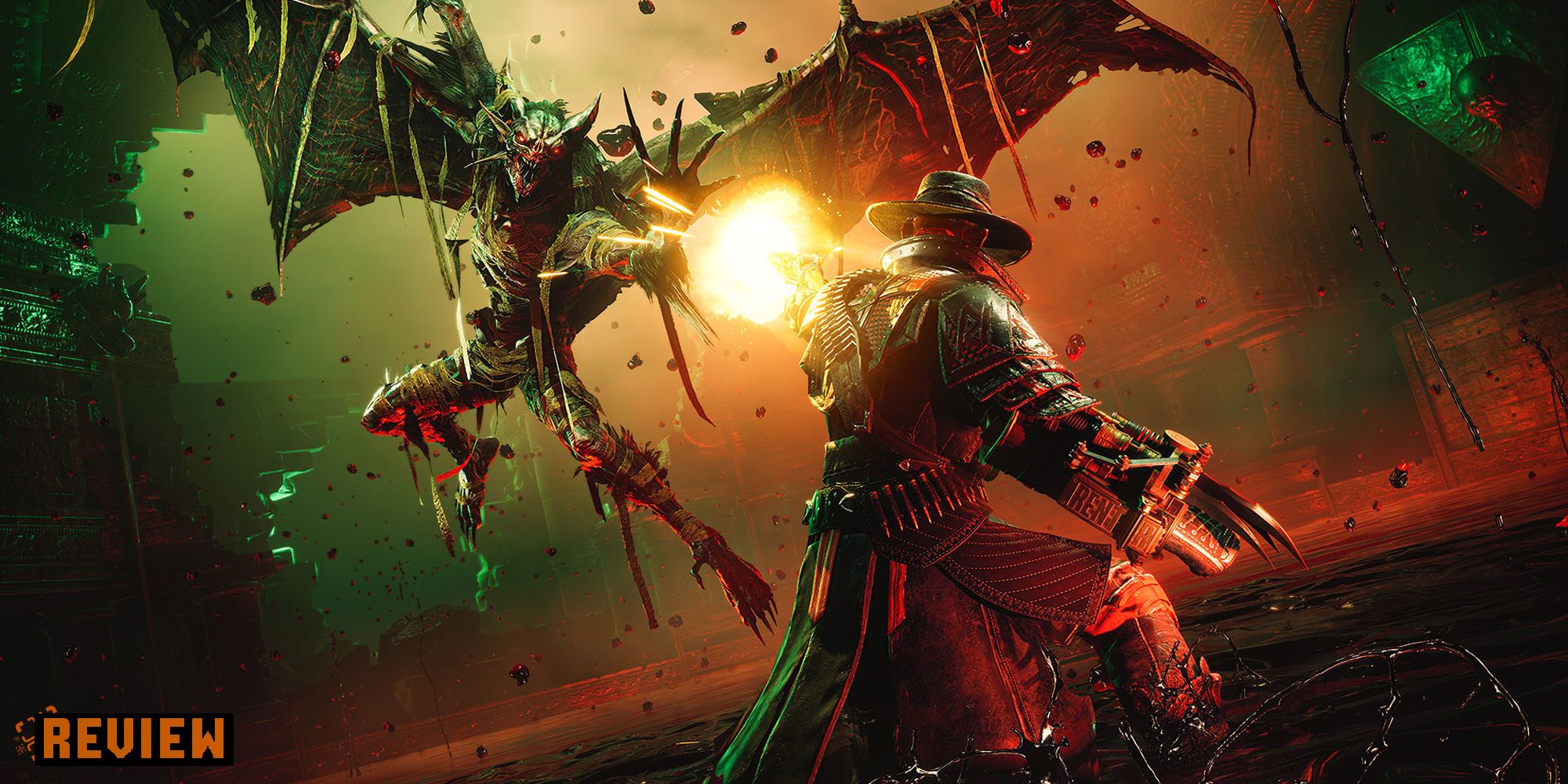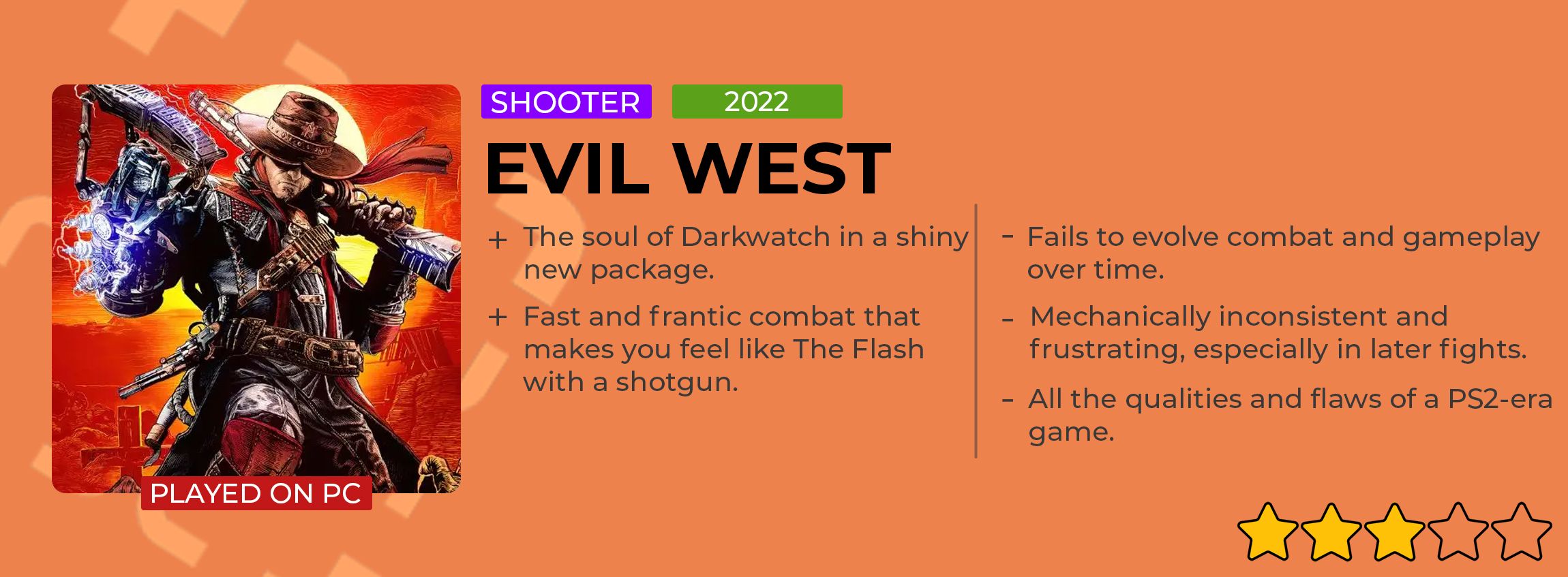After successfully resurrecting Shadow Warrior, it’s easy to imagine studio Flying Wild Hog setting its sights on another cult classic shooter, High Moon’s vampire western Darkwatch. I can’t say for certain whether or not Evil West started out as a Darkwatch reboot - though I can tell you the original Darkwatch creators would have bought the rights back from Activision if they could have - it is clear that the spirit of Darkwatch lives on in Evil West. It’s more than just a passive resemblance. From the secret government organization that wages a shadow war against the forces of evil, to the gruff cowboy hero’s high-tech arsenal of teslapunk weaponry, Evil West uses Darkwatch’s haunted west as a template. Heck, even the folder where your save files are stored on PC is labeled “highmoon”. It’s not just an ode to the world of Darkwatch though, it also embodies the PS2-era of action games, warts and all. Evil West’s simple, linear gameplay is at once a charming throwback to a time before quadruple-A games dominated the market, and a stark reminder that action games have come a long way in the past 15 years.
Evil West’s 12-hour campaign follows Jesse Rentier, vampire hunter and heir to the government-funded Rentier Institute, founded by his father William. While investigating a sudden surge in demonic forces, the Rentier Institute is attacked and William is bitten by a vampire. Across 16 missions, Jesse attempts to find a cure for his father and stop a new vampiric threat, all the while unlocking new weapons, upgrading his electrifying abilities, and endlessly fighting in arenas filled with zombies, ghouls, and all manner of the undead. Like most games made in the mid-aughts, Evil West has a shallow-but-serviceable story filled with two-dimensional characters, corny dialogue, and some pretty questionable deliveries. It’s occasionally charming, but more often the non-gameplay elements just feel like they exist because they have to. Just as there’s a distinction in film between camp and lousy production, there’s also a line in games between retro-inspired and outdated, and Evil West is too often on the wrong side of it.
Each mission is a trudge from point A to point B with a dozen or so fights along the way. Jesse has an impressive assortment of weapons that grows even more impressive over time, and the ever-increasing numbers Evil West throws at you demands that you use them all. Much like new Doom’s swiss army approach to combat, Evil West bestows you with a rifle, shotgun, electric fist, pistol, crossbow, and even more tools that you can easily combo together for maximally efficient carnage.
Rather than task you with micromanaging ammo or cumbersome weapon select wheels, Evil West cleverly puts all of your tools on separate buttons with their own individual cooldowns. A quick glance at the corner of the screen shows which abilities and weapons are available to you, which leads to a lot of thrilling moments when you just need to survive for one more second until a healing power or a big AoE stun comes back online. One of the combat’s biggest strengths is how quickly the tables turn on both sides, depending on your available resources and the undead’s reinforcements. It’s both terrifying and exciting to watch Jesse’s health yo-yo up and down as you tank damage from all sides and do finishing moves to produce instant healing - another quality borrowed from Doom.
The novelty of Evil West is your ability to dash across the battlefield with lightning speed to pummel distant enemies, or alternatively, yank them toward you using an electric lasso. This mobility allows for massive arenas filled with dozens of enemies all attacking you at once. When Evil West is at its best it makes you feel like a superhero, wildly dashing around like The Flash, unleashing a rapid flurry of hits into monsters and dumping electrified buckshot into their heads. That last part probably only applies to Zack Snyder’s version of The Flash, but you get the picture.
Unfortunately, Evil West’s strengths eventually become its weaknesses. The only way that complexity and difficulty ever increase is in the number of big, spongey enemies you’re asked to fight simultaneously, which makes things harder, but not more interesting. The mechanical limitations start to reveal themselves more and more as you face bigger and bigger mobs. Targeting the right enemy for a dash becomes more inconsistent, the hidden range limitation for pulling monsters towards you becomes more frustrating, hammering the same button to rapidly punch the same manbat you’ve punched a hundred times already becomes more tiresome, and watching your camera lock onto the wrong enemy again and again is infuriating, especially since you’re constantly required to react instantly to threats with a counter-shot. In the latter half of the game when each arena is filled with mini-bosses, the biggest threat to you becomes the uncooperative camera. Frequently dying in the early hours feels like a learning experience, but eventually it starts to feel frustrating and unfair.
Its proximity to the release Ragnarok will also invite some unflattering comparisons to God of War, which is unfortunate, but not unwarranted. The linear missions offer the same tired version of exploration where two paths diverge, one leading to gold, lore, or a collectible (different colorways for Jesse’s weapons and outfits, yawn) while the other will continue along the critical path. Choose incorrectly, and you’ll jump over a one-way hurdle, leaving you with that irritating feeling that you missed something important. The puzzles amount to little more than pushing a box into a wall so you can climb up it, or run across some floating platforms before they can sink, and these are the only gameplay moments that break up the combat. The only incentive to explore the brief alleyways along the main path is to find the money you need to unlock new abilities on your talent tree, which is filled with uninspired passives that don’t have much impact on your playstyle. It’s difficult to get excited about bonus damage to airborne enemies or one extra bullet in your pistol, but that’s all the power you have to pursue.
It’s my responsibility to mention that my playthrough ended prematurely on the 12th mission, when a game-breaking bug stopped me from progressing any further. This puts me in a tough situation. I’ve never reviewed a game I haven’t finished before, but my job is to be honest about my experience, and if I’m being honest, not being able to finish the game is, as you might imagine, a huge bummer. This was far from the only major bug I encountered, which included dying after getting stuck on invisible geo, dying after falling through the ground, dying when my dash attack just wouldn’t activate, and dying when the stun kick didn’t stun my target. For what it’s worth, the developers are looking into solutions for me and it doesn’t sound like other reviewers ran into this hard lock. That said, my impressions have only gotten worse over time, so I doubt the last couple of hours would have improved my feelings about it.
It’s important to assess the quality of any art based on how successful it is at whatever it’s trying to do. Evil West wants to be a PS2-era game and a spiritual successor to Darkwatch, and in that it is quite successful. The problem is that it’s not 2005, and despite what our nostalgia-addled brains tell us, games have gotten a lot better since then. Evil West has a lot of the qualities we miss from that era - shorter, weekend-length experiences, no filler or bloated open-worlds, no characters constantly chattering on - but it also has all of its flaws. There’s no reason a 12-hour game should wear out its welcome so thoroughly by the eighth hour, but Evil West fails to grow beyond its core design to complicate and innovate with its gameplay, instead opting to just throw more and more threats at you until it buckles under the weight of its own poor design. Though it captures the heart of Darkwatch in its environments and atmosphere, it can’t make up for its lack of variety or its inability to scale difficulty in a satisfying way. The best throwback games borrow aesthetics, iconography, and mechanics from the past, and blend them with modern sensibilities. Evil West does the first part beautifully, but can’t quite pull things together for audiences today.


